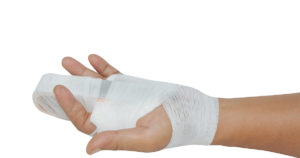Preventing Workplace Hand Injuries
April 22, 2020 According to the Bureau of Labor Statistics (BLS), every year approximately 1 million workers require emergency medical care for hand injuries that they sustain on the job. In fact, in the United States hand injuries are the second-leading cause of workplace injury. For many workers a hand injury can result in physical and financial consequences, both of which can be devastating. In order to prevent debilitating hand injuries from happening and to protect workers from recognizable hazards, employers must comply with the Occupational Safety and Health Administration’s (OSHA) protective federal regulations.
According to the Bureau of Labor Statistics (BLS), every year approximately 1 million workers require emergency medical care for hand injuries that they sustain on the job. In fact, in the United States hand injuries are the second-leading cause of workplace injury. For many workers a hand injury can result in physical and financial consequences, both of which can be devastating. In order to prevent debilitating hand injuries from happening and to protect workers from recognizable hazards, employers must comply with the Occupational Safety and Health Administration’s (OSHA) protective federal regulations.
Types Of Hand Injuries And How They Happen
Some of the most common types of hand injuries are crushing injuries, lacerations, and fractures. Crushing injuries most frequently occur when a worker places his or her hands between two objects or in between rotating machine parts or moving equipment. The risk of this kind of injury is much higher when a machine is unguarded or improperly guarded. One of the most common kinds of crushing injuries is a pinch point injury, which happens when a machine’s moving part comes into contact with another part or surface. Personal protective equipment, or PPE, does not always guard completely against crushing and pinch point injuries but creating a workplace culture that includes regularly inspecting and maintaining machinery, as well as providing in-depth employee training can. But remember, it is critical that employers guard machinery in compliance with OSHA’s machine guarding standards.
Fractures happen when a bone breaks completely or partially. Workers who break their hand or finger(s) on the job are usually involved in falls or motor vehicle accidents, though they can also happen after a sudden blow to the bones in the area. Laceration injuries usually involve sharp objects or tools, which is why gloves – which are the most common type of PPE in the workplace – can protect workers from getting seriously hurt while performing certain tasks. Protective gloves can reduce the risk for hand injuries as much as 60%, but employers and supervisors need to make sure that they are the right ones for the job, that they fit properly, and that workers wear them when they should. Another effective control measure for lowering the number of fracture and laceration injuries is to comprehensively train workers on injury prevention and safe tool handling techniques.
Who Is Responsible For Preventable Workplace Injuries?
Employers are legally responsible for providing workplaces free from recognizable hazards. They also must comply with OSHA’s rules, regulations, and health and safety standards for maintaining a safe workplace. Sometimes an employer’s negligence, cutting corners or their failure to prioritize employee safety leaves workers to face serious injury and hazard risks – and as a result, preventable injuries happen. When a worker is injured because of safety failures on the job, he or she may want to consider filing a workers’ compensation claim. Workers’ compensation is a type of insurance that provides medical benefits and wage replacement to injured workers.
In some cases a third party may be partially or fully responsible for a workplace injury. For example, if a machine is sold in an unsafe condition – whether it results from a manufacturing or design defect – and it causes injury to someone, that person has the right to file a legal claim. According to the National Safety Council (NSC), inadequately guarded or unguarded machinery causes approximately 15% of all industrial injuries, despite the fact that a machine with moving parts should always have fixed or interlocking guards to prevent this type of accident from happening. Determining liability in these cases can be difficult, but speaking to an attorney can help.
At our firm, we have attorneys who are experienced with navigating both workers’ compensation and product liability claims. If you have questions about an injury that happened at work and want to know more about filing a claim, contact a representative online now.
Philadelphia Workers’ Compensation Lawyers at Galfand Berger, LLP Represent Individuals Injured at Work
With offices located in Philadelphia, Bethlehem, Lancaster, and Reading, Galfand Berger serves clients throughout Pennsylvania and New Jersey. To schedule a consultation, call us at 800-222-8792 or complete our online contact form.
 Google Screened
Google Screened
